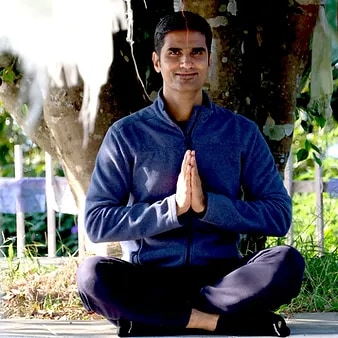Yoga for Stress Management: Your Path to Inner Peace
by Hardik Mehta

In today’s fast-paced world, stress has become an inevitable part of our lives. It can wreak havoc on our physical and mental well-being, leading to various health issues. However, there is a powerful and holistic solution that has been practiced for centuries – yoga. This ancient practice offers a wealth of benefits for stress management, promoting relaxation and inner peace. In this blog, we will explore the profound impact of yoga on stress relief, its various techniques, and how to incorporate it into your daily life. Let us embark on a journey towards a stress-free and harmonious existence.
Understanding Stress
Before delving into the world of yoga for stress management, it is essential to comprehend what stress is and its effects on our lives. Stress is a natural response to challenging situations, but when it becomes chronic, it can lead to anxiety, depression, and physical health problems. It can manifest in various forms, such as work-related stress, family issues, or personal insecurities. Yoga offers a multi-faceted approach to tackling these issues, making it a versatile tool in your stress management toolkit.
The Science Behind Yoga
Yoga’s effectiveness in stress management is not just a matter of anecdotal evidence – there’s science backing it up. Yoga activates the parasympathetic nervous system, which is responsible for the body’s “rest and digest” response. This activation counteracts the stress-induced “fight or flight” response, leading to reduced heart rate, lowered blood pressure, and increased feelings of calm and relaxation. In addition, yoga promotes the release of endorphins, the body’s natural mood lifters, which can counteract the negative effects of stress hormones.
Yoga Techniques for Stress Management
Now, let us explore some of the most effective yoga techniques that can help you manage and reduce stress in your life.
- Hatha Yoga: Hatha yoga combines physical postures (asanas) with controlled breathing (pranayama) to enhance physical and mental well-being. It helps increase flexibility, strength, and balance while calming the mind.
- Meditation and Mindfulness: Meditation is a powerful tool for stress reduction. By focusing your mind and eliminating distracting thoughts, you can achieve mental clarity and emotional balance. Mindfulness, a form of meditation, encourages living in the present moment, reducing worry about the past and future.
- Yoga Nidra: Yoga Nidra, or yogic sleep, is a deeply relaxing practice that helps you achieve a state of conscious relaxation. It can alleviate tension, anxiety, and insomnia, providing much-needed relief from stress.
- Deep Breathing: Pranayama, or breath control, is an integral part of yoga. Techniques like the 4-7-8 breath or Kapalbhati can help you manage stress by promoting calmness and relaxation.
- Restorative Yoga: This gentle form of yoga uses props like bolsters and blankets to support the body in various postures. It is perfect for reducing physical and mental tension.
- Sound Healing: Soothing sounds and vibrations can induce deep relaxation and reduce stress. These harmonious tones can help calm the mind, release tension, and promote a sense of inner peace, making it an effective tool for stress management.
Building a Yoga Practice
To reap the full benefits of yoga for stress management, it is essential to build a regular practice. Start with a few minutes each day, gradually increasing the duration as you become more comfortable. Find a quiet, comfortable space for your practice, and consider seeking guidance from a qualified yoga instructor to ensure you are performing the postures and techniques correctly. Yoga can be done virtually anywhere, making it a convenient tool for managing stress.
Yoga is not limited to your mat – it is a philosophy that can be integrated into your daily life. Here are some practical tips for incorporating yoga into your routine:
- Mindful Eating: Practice mindful eating by savouring each bite, focusing on the Flavors, and eating slowly. This can reduce stress and improve digestion.
- Breathing Exercises: Use the breath control techniques you have learned in yoga to calm your mind during stressful moments throughout the day.
- Stretch Breaks: Take short stretching breaks during your workday to release tension and promote relaxation.
- Gratitude Journal: Start or end your day by jotting down things you are grateful for. This practice can shift your focus from stress to positivity.
5 Best Yoga Poses for Stress Relief

1. Child’s Pose, or Balasana, is an excellent yoga pose for stress relief. This restful posture helps relax your mind and body by stretching the spine, releasing tension in the back and neck. Incorporating Balasana into your daily routine can provide an instant sense of calm.

2. Shavasana, also known as Corpse Pose, is the ultimate relaxation pose. It involves lying down flat on your back with your arms and legs comfortably extended. This pose helps you surrender to complete relaxation, reducing stress and anxiety.

3. The Cat-Cow Pose is a gentle, flowing sequence that combines Marjaryasana (Cat Pose) and Bitilasana (Cow Pose). This dynamic movement helps relieve stress by increasing flexibility in the spine and promoting deep, mindful breathing.

4. Bridge Pose, or Setu Bandhasana, is a wonderful way to release tension in the neck, shoulders, and lower back. It also stimulates the thyroid gland, which can help regulate stress hormones. Practice this pose regularly for physical and emotional relief.

- Viparita Karani, or Legs-Up-The-Wall Pose, is a simple yet effective way to ease stress. By elevating your legs against a wall, blood circulation improves, and the nervous system relaxes. This pose is particularly beneficial for those dealing with anxiety or insomnia.
How to use pranayama to reduce stress
- Start by finding a quiet, comfortable space. Sit or lie down in a relaxed posture.
- Close your eyes and take a deep, slow breath in through your nose, allowing your abdomen to rise as you fill your lungs.
- Exhale slowly through your mouth, releasing tension with each breath. Focus on the rhythm of your breath, letting go of intrusive thoughts.
- Practice deep, intentional breathing for a few minutes. This mindful approach calms the nervous system, lowers cortisol levels, and promotes relaxation, effectively alleviating stress.
- Incorporate pranayama into your daily routine for a sustained sense of calm and well-being.
In a world filled with stressors, yoga is a beacon of hope for those seeking relief. Its centuries-old wisdom and scientifically proven benefits make it a formidable ally in the battle against stress. By incorporating yoga into your daily routine, you can transform your life and experience a sense of inner peace and well-being like never before. So, unroll your yoga mat, breathe deeply, and embark on a journey toward a stress-free, balanced existence.
About the Author

Hardik Mehta
Hardik is an E-RYT 500 & YACEP (Yoga Alliance Continuing Education Provider), Yoga Alliance, USA. He has been practicing yoga for the last 9 years. Prior to finding his true calling in Yoga, he was working with various corporates for 12 years in the Retail and eCommerce sector.
